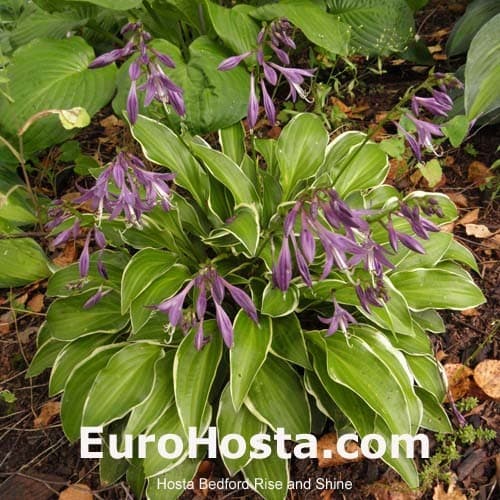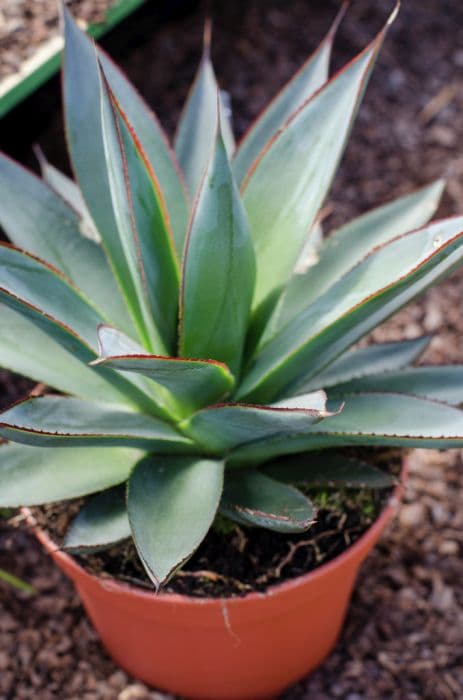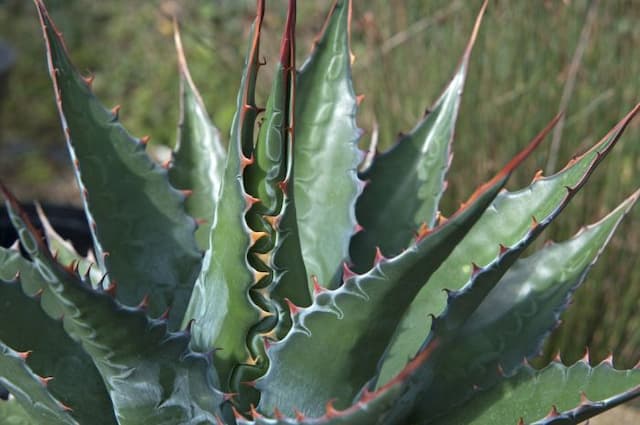Hosta Hosta 'Bedford Rise and Shine' (v)

ABOUT
Hosta 'Bedford Rise and Shine' is a striking ornamental plant commonly known for its lush foliage. It has broad leaves which are thick and heavily corrugated, allowing them to exhibit a unique texture that adds a tactile dimension to the visual appeal of the plant. The leaves display a rich, deep green color with a glossy sheen that can appear both vibrant and serene in a garden setting. The foliage tends to form a low-growing mound, creating a dense, leafy presence that can be appreciated for its shade-tolerant characteristics. During its blooming season, the Hosta 'Bedford Rise and Shine' produces flowers that rise above the foliage on tall stalks. These flowers are typically bell-shaped and can be an appealing shade that stands out against the green backdrop of the leaves. The robust nature of the leaf structure paired with its impressive green hue makes this particular hosta a beautiful addition to any garden. It provides a lush, verdant aesthetic that is both pleasing to the eye and effective for filling out shaded spaces with texture and color.
About this plant
 Names
NamesFamily
Hostaceae.
Synonyms
Plantain Lily, Funkia.
Common names
Hosta 'Bedford Rise and Shine'
 Toxicity
ToxicityTo humans
Hostas are not considered toxic to humans. They are sometimes even used in culinary applications, especially in some Asian cuisines. Therefore, eating hostas, including Hosta 'Bedford Rise and Shine', typically does not result in poisoning or harmful effects to humans.
To pets
Hostas, although not toxic to humans, are poisonous to pets such as dogs and cats. If a pet ingests any part of a hosta plant, the animal may experience symptoms including vomiting, diarrhea, and depression. The severity of these symptoms can vary based on the amount of plant material ingested. It is important for pet owners to prevent their animals from eating hostas to avoid these potential adverse health effects.
 Characteristics
CharacteristicsLife cycle
Perennials
Foliage type
Deciduous
Color of leaves
Green
Flower color
Lavender
Height
2 feet 24 inches (60 cm)
Spread
2 feet 24 inches (60 cm)
Plant type
Herb
Hardiness zones
3
Native area
Asia
Benefits
 General Benefits
General Benefits- Shade Tolerance: Hostas are well-known for their ability to thrive in shaded areas where other plants may struggle, making them an ideal choice for garden spots with limited sunlight.
- Low Maintenance: Once established, Hostas require minimal care, making them suitable for both novice and experienced gardeners.
- Attractive Foliage: Hostas are primarily grown for their beautiful foliage, which varies in color, texture, and pattern, adding visual interest to gardens.
- Drought Resistance: They are relatively drought-tolerant, reducing the need for frequent watering once established.
- Pest Resistance: Although slugs can be a problem for some Hostas, overall they have good resistance to pests and diseases.
- Long-lived: Hostas are perennial plants, meaning they come back year after year, providing long-term beauty with the right care.
- Variety of Sizes: Available in different sizes, Hostas can fit into various garden spaces, from small borders to larger landscape areas.
- Ground Cover: They can serve as effective ground cover, reducing weed growth and soil erosion in gardens.
- Seasonal Interest: Some Hosta varieties offer blooms in addition to their attractive foliage, adding seasonal interest to the garden.
 Medical Properties
Medical PropertiesThis plant is not used for medical purposes.
 Air-purifying Qualities
Air-purifying QualitiesThis plant is not specifically known for air purifying qualities.
 Other Uses
Other Uses- Artistic inspiration: Illustrators and designers may use the striking leaves and overall form of the Hosta as inspiration for patterns, textile designs, and artwork.
- Natural dyes: The leaves of the Hosta can be used to create natural dyes for fabrics or art projects, offering a range of green hues.
- Culinary decoration: Though not a traditional use, the large, attractive leaves can be used as a natural platter or decorative base for presenting hors d'oeuvres at garden parties.
- Craft projects: Leaves can be pressed and dried to be used in craft projects, such as making bookmarks, greeting cards, or in decoupage.
- Photography subject: Hostas can provide an interesting subject or backdrop for photographers, especially when capturing the intricate details of morning dew or raindrops on their leaves.
- Education: Hostas can be used in educational settings to teach about plant growth patterns, variegation, and the diversity of plant forms in horticulture.
- Garden design and planning tool: The Hosta can serve as a landscape architecture model when planning gardens, demonstrating shade tolerance and foliage contrast.
- Leaf casting: Hosta leaves can be used in creating concrete or plaster casts for garden ornaments or artistic projects due to their detailed veining.
- Habitat enrichment: In zoos or wildlife enclosures, non-toxic plants like Hostas can be introduced to enhance the habitat for certain animals.
- Biodegradable food containers: Innovative uses may include creating biodegradable containers or wrappers using Hosta leaves for an eco-friendly alternative to disposable plastic.
Interesting Facts
 Feng Shui
Feng ShuiThe Hosta is not used in Feng Shui practice.
 Zodiac Sign Compitability
Zodiac Sign CompitabilityThe Hosta is not used in astrology practice.
 Plant Symbolism
Plant Symbolism- Resilience: Hostas symbolize resilience as they are hardy plants that can thrive in a variety of conditions and come back year after year, even after harsh winters.
- Devotion: The way hostas can persist in the same spot for many years can be seen as a sign of devotion and long-term commitment.
- Hardiness: Known for their ability to withstand shade and less than ideal soil conditions, hostas represent the trait of hardiness in the face of adversity.
- Adaptability: The hosta's ability to adapt to different lighting conditions makes it a symbol of flexibility and the capacity to thrive in various environments.
- Heartiness: With their robust nature and substantial foliage, hostas can symbolize a hearty spirit or robust health.
- Shelter: The broad leaves of hostas often provide shelter to small creatures, thus symbolizing protection and refuge.
- Friendship: Due to their long lifespan and the way they expand and grow fuller with time, hostas can symbolize enduring friendship and relationships that grow stronger over the years.
 Water
WaterHostas, including 'Bedford Rise and Shine', prefer consistently moist soil, so it's important to water them regularly. During the growing season, aim to water them with about 1-inch of water per week, which is roughly 0.6 gallons per square yard of soil. Adjust your watering schedule according to weather conditions; they may need more water during dry spells or less if it's rainy. Avoid overhead watering to minimize the risk of leaf diseases, and instead water at the soil level. During the winter months, reduce watering since the plants are dormant and require less moisture.
 Light
LightHostas, such as 'Bedford Rise and Shine', thrive best in partial to full shade. They will do well in a spot that receives morning sunlight and is shaded in the afternoon, as the hot midday sun can scorch their leaves. Bright, indirect light is ideal for these plants, so placing them under the canopy of trees or on the north side of a building can offer the right conditions.
 Temperature
TemperatureHostas, including 'Bedford Rise and Shine', are hardy in a wide temperature range. They can generally tolerate minimum temperatures down to about 30 degrees Fahrenheit, but they thrive in temperatures between 50 and 75 degrees Fahrenheit. During the winter months, they can survive cold snaps in temperatures as low as those typical of USDA Hardiness Zones 3 through 9, but they should be protected from extreme fluctuations and freezing conditions.
 Pruning
PruningPruning Hostas such as 'Bedford Rise and Shine' typically involves removing dead or damaged leaves to maintain the plant's appearance and health. Pruning is best done in the early spring or as needed throughout the growing season. In late fall, once the leaves have died back, you can cut the foliage down to ground level to tidy the plant for winter. Annual pruning can also stimulate new growth and improve air circulation, helping to prevent disease.
 Cleaning
CleaningAs needed
 Soil
SoilThe best soil mix for hostas should be well-draining, rich in organic matter, and slightly acidic to neutral in pH (6.0 to 7.0). A mix using equal parts garden soil, peat moss, and perlite or coarse sand is ideal to provide the necessary drainage and nutrient retention.
 Repotting
RepottingHostas, including 'Bedford Rise and Shine', typically require repotting every three to five years, or when they become root-bound. Repotting is best done in the spring before the leaves fully unfurl.
 Humidity & Misting
Humidity & MistingHostas prefer a moderate level of humidity but are quite adaptable to various conditions. For best results, maintain a humidity level between 50% to 70% for 'Bedford Rise and Shine'.
 Suitable locations
Suitable locationsIndoor
Ensure bright, indirect light and keep the soil moist.
Outdoor
Plant in partial shade, keep soil moist, and protect from harsh sun.
Hardiness zone
3-9 USDA
 Life cycle
Life cycleThe Hosta, commonly known as the plantain lily, begins its life cycle as a seed, which, when sown, will germinate and sprout into a seedling under the right conditions of warmth and moisture. The seedling grows into a juvenile plant, developing a small rosette of leaves that emerge from a central crown. As the Hosta matures, it enters a vegetative stage where it expands its leafy foliage, known for its variegated patterns and often impressive size, and establishes a strong root system. Once the Hosta reaches maturity, it will produce tall flower stalks, typically in the summer, bearing funnel-shaped flowers that can attract pollinators like bees. After flowering, the Hosta sets seeds, which can disperse to start new plants, completing its reproductive cycle. During the winter or in response to adverse conditions, Hostas die back to the ground, with the crown going dormant, only to regrow the following spring.
 Propogation
PropogationPropogation time
Early Spring
Propogation: Hosta 'Bedford Rise and Shine', commonly referred to as Hosta or Plantain Lily, is typically propagated through division, which is the most popular method for multiplying these plants. The best time to propagate Hostas by division is in the early spring or late summer, ideally when the plant is not in active growth. To propagate by division, carefully dig up the entire hosta plant and gently wash the soil off the roots. This will make it easier to see how the clump is structured. Look for natural divisions in the root ball and use a sharp knife or spade to cut the clump into smaller sections, ensuring each section has at least 2 to 3 shoots or "eyes" and a portion of the root system. Replant each division at the same soil depth as it was previously growing, and water thoroughly to help establish the new plants.









